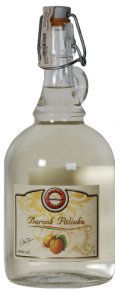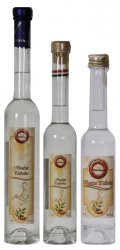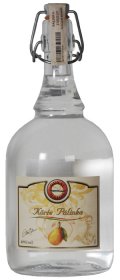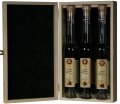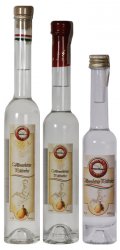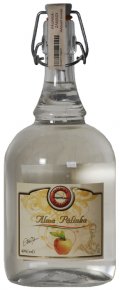Technological and technical description
 for the licence of Vecse-komplex Ltd. (1085 Budapest Mária u. 10.) Dunavecse home-distilled distillery.
for the licence of Vecse-komplex Ltd. (1085 Budapest Mária u. 10.) Dunavecse home-distilled distillery.
The planned fruit processing plant is settled the outer area of Dunavecse, 200meters from downtown, surrounded by public utilities. Cold-storage plant, drying house and distillery is going to be built on the spot. The following technical review concerns only the distillery. Our home-made distillery is suitable both for payed and commercial distillation.
A. PAYED DISTILLATION - DISTILLATION FOR HIRE
The process of payed distillation is the following: receiving the material, distillation, delivery of the finished product.
A. 1. Receiving the material
We receive mash from our clients in covered plastic barrels, which always starts with quality examination in the presence of the customer, when the quality of the distillable fruit is determined by manual refractometer and survey. Pouring on follows the sampling. In case of fruit mash the basic material directly gets into the 1500 litre receiving buffer containers before pump it into one of the stills through the closed piping.
The mash gets from the the reciever tank to the filling-pump by gravitation; the buffer container is double walled and made of stainless steel with sloping bottom. In case of grape-skin mash grinding comes first then comes the above-mentioned pouring on. Our customers may wash their mash containers on the spot.
A. 2. Distillation
Home-distillation is a closed technological process. In our distillery we have 2 pieces of 500 litres of useful volume, duplicated, water-jacketed, natural gas-heated stills plus the belonging production line (cooler, 250 l refiner still, alcoholmeter etc.) is going to be settled. These two same distillation techniques both able for paid and commercial distillation but in case of commercial distillation, the technological process is different.
The still can be filled up with pre-heated mash to 80% of their volume. The still is a closed system supplied with a special pouring slot and head with vapour pipe, in which the mash begin to boil due to the steam-heating. The developing humes get into the refrigerator through the stilted head and vapour pipe, and as a result of the applied refrigeration condensation takes place.
The condensed tail purifies through the filtering apparatus and gets into the collector tank through eprouvettes, then into the refiner still of 250 litre where due to gas heating it starts boiling again. The developing fumes is condensed in every plate in the amplifier, reach the boiling heat on every switched on plate then through the refrigerator and vapour pipe it gets into the pipe bundled refrigerator where due to cooling it condensed again and become liquid. The condensed pálinka gets into the pálinka-collector tank through eprouvettes and the alcoholmeter.
After pre-heating the next mash, the developing warm cooling water (50 °C) gets into the technological sewer through cooling-tube. After the distillation of raw materials the malt returns gets into the mash-container through built-in pipes. We are going to build 2 15 m3 mash-containers. One of these will be able to collect malt returns of one week. When the container is full, we pump malt returns into the other. After resting, diluting and setting pH level the malt returns is used up in tillage watering.
The tail and subsequent alcohol, tail sewage (lutter water) is get into a sewer – later it will be destroyed. We are going to settle alcohol sensors and emergency ventilation holes into the distillery in case of average. Setting the alcohol content of the paid-distilled pálinka happens in the mixer-tank by adding deionised water.
A. 3. Delivery of the finished product
After measuring the condensed liquid– in the presence and with the participation of the customer – we drain the finished product into the condenser receiver then pour the pálinka into the customer’s container.
(paying the invoice at the same time). Customers take the finished product away by their own car.
B. COMMERCIAL DISTILLATION
The process of the commercial distillation: preparation of the fruits, mashing, distillation, maturing, bottling, sale
B. 1. Preparation of the fruits
As it was mentioned in the introduction, there will be cold-storage plant(20t capacity) and drying house as well on our spot. We store fruits when processing doesn’t begin right after the acceptance. Fruit processing happens before dehydration. After receiving comes washing, sorting and chopping. After chopping the fruits, the process divide into two parts: distillation and dehydration. The capacity of the fruit process line is 2 to/h. Generally plum, apricot, apple and pear are processed. After washing selecting chopping, grinding, stoning, passing should be taken – especially in case of fruits to be home-distilled – to avoid the unpleasant flavour of the finished product (obtain cyan content). Through chute-pipes the pulp gets into a pump where the sarcocarp containing sugar are smashed to pieces for the better fermentation by the method of whirling. The pulp buffer-container is next to the pump, we have the first sample from this container. (the mash is pumped into the plastic fermenting tanks from the pulp tanks)
B. 2. Mashing
The fermenting tanks are made of PP plastic, these are equipments of the food-industry, with water lock (shutting out Co2) or membrane valve. Stirring in the fermentation yeasts might be through the upper dome, but we can help fermentation by using manual mixer (blade wheel with a long handle). Mash containers should be filled up only to 75-80%, because in case of reduction or expansion of volume the mash cork moves.
We don’t affect the natural fermentation, maturation of the mash. Materials to be fermented are fructose and glucose. Alcoholic fermentation of the six-carbon atom monosaccharides and disaccharides is advised to be taken with the yeast of sacharonyces cerevisiae. Generally, in case of apple or pear, we get 90 l of mash and 5 l of pálinka, in case of plum or apricot we get 92 l of mash and 6 l of pálinka out of 100 kg of fruit. We are planning to start with 9pcs 5m3 mash-containers, with about 45 m3 capacity.
The 3 steps of of fermentation are: main fermentation or noisy fermentation 3-5 days (max. 1 week), slow fermentation or post-fermentation, finally the storage before distillation close the process. The temperature, sugar- and alcohol content, the pH value of the fermenting mash (2,8-3,2) is necessary to be checked continuously. Post-fermentation generally takes 3 weeks on 20C.
During the storage period the most important task is to keep the quality of the mash. The average temperature of storage and maturation is 16°C. Damage of the mash is primarily caused by aerob acid bacterium organizations – with hermetic sealing their multiplication can be avoid. The surface of the fermented mash should be locked air-tight although the CO2 fumes protect the mash as well. We pimp the riped quality mash from the containers into the preheating tanks with CsN-200-R mobile pump. (preheating tank was already mentioned in chapter „paid distillation”)
B. 3. Distillation
You can read detailed representation of distillation procedure in chapter 2. In case of commercial distillation 80° pálinka is filtered with stainless steel sediment filter then pumped into stainless steel alcohol tanks (2000 l) or wood barrels.
B. 4. Maturing
After setting the appropriate alcohol-content the fruit-distillate start its maturation in 3pcs 2m3 stainless steel alcohol tanks and about 8 pcs gönci barrels, which is 7,3 m3 capacity at all. The maturation room is advised to be supplied with safety-lock, code-key and motion sensors. The data of the maturation and quality are must be recorded in the journal.
B. 5. Bottling
The pálinka with appropriate alcohol-content is pumped into the bottling machine, which bottles it into „foundry-clear” 0,5 l form glasses. Before bottling, bottles are get washed, rinsed through the bottle-washing plant.
Equipments of bottling
Bottling is done with AUSONIA 4-headed semi-automatic bottling machine with low vacuum.
Bottle closing is done with ETER AA one-headed closing machine.
Labelling is done with SELENIA semi-automatic labelling machine.
Ausonia bottling machine and Eter bottle closing machine are settled on a common table.
The bottling is finished by putting on the tax stamp. It is necessary to preserve and store samples taken from the drinks before bottling. Labouratory check is also necessary during the whole process of production. the capacity of finished product stock is 20 m3.
B. 6. Sale
Labelled bottles should be stored in cardboards on pallets. Delivery by public vehicle. In the distillery we use manual trucks, hand-trolleys, pumps to move materials. The main direction of material movement in case of paid-distillation: receiving the mash (grape-skin grinder), distillation, delivery to the customer.
Direction of material movement in case of commercial distillation. Fruit-preparing, pulpify, mash-maturation, mash-receiving, distillation, maturation-room, bottling, packing.
The way of the bundle: bundle storage, bottle-washing, bottling or storing the bundle, tax-stamp storage, bottling. For the appropriate steps of forming the depository see chapter B.4, which refers to the tax-stamp storage as well.
Observance of Act of 1955., 1/1996 (I.9.) FM-NM-IKM Decree, 17/1999.II.10. FVM-EüM and 17/1999.VI.16. EüM Decree during the implementation (building and mending).
Severe observance of regulation 32/1994./XI.10/IKM decree of Safety Regulation of Constructing of Building Industry during the implementation works. Severe observance of standards of No. MSz-04-900-905 connected to work safety as well.
It is necessary to have a stock of appropriate quality protective wear at the workplace and demand their wearing. During wintertime, employer must pay attention to conditions being suitable both for the work the workplace.
Pipes under pressure must be checked with compression test, as well as isolations (which is typical to the circulating substance.)



